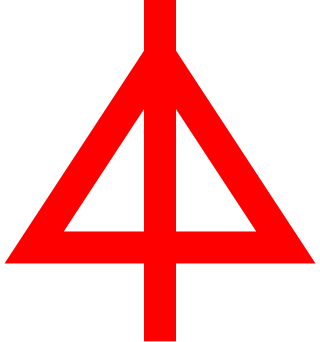| 102nd Panzer Brigade | |
|---|---|
| Active | 15 August - 27 November 1944 |
| Country | |
| Branch | Army |
| Type | Panzer |
| Role | Armoured warfare |
| Size | Brigade |
| Engagements | World War II |
The 102nd Panzer Brigade was a Panzer Brigade that fought in World War II.
| 102nd Panzer Brigade | |
|---|---|
| Active | 15 August - 27 November 1944 |
| Country | |
| Branch | Army |
| Type | Panzer |
| Role | Armoured warfare |
| Size | Brigade |
| Engagements | World War II |
The 102nd Panzer Brigade was a Panzer Brigade that fought in World War II.
Ordered to be formed on 20 July 1944, it was not formed until 15 August 1944. [1] The brigade was deployed on the Eastern Front and was involved in the Battle of Gumbinnen. The brigade was disbanded on 27 November 1944 and absorbed to the 7th Panzer Division. [1]

The 5th Panzer Division was an armoured division of the German Army during World War II, established in 1938.

The German Army is the land component of the armed forces of Germany. The present-day German Army was founded in 1955 as part of the newly formed West German Bundeswehr together with the Marine and the Luftwaffe. As of January 2022, the German Army had a strength of 62,766 soldiers.
The Panzergrenadier Division "Großdeutschland", also commonly referred to simply as Großdeutschland or Großdeutschland Division, was an elite combat unit of the German Army that fought on the Eastern Front in World War II.
Panzer Division Feldherrnhalle 2 was a late World War II German Wehrmacht panzer division. Commanded by Franz Bäke, it was formed in March 1945 of the remnants of other divisions and stationed with a home base at Wehrkreis XX. It was moved to Slovakia in 1945, where it fought its only battles. It was later disbanded.

The Panzer-Lehr-Division was an elite German armoured division during World War II. It was formed in 1943 onwards from training and demonstration troops stationed in Germany, to provide additional armored strength for the anticipated Allied invasion of western Europe. On 4 April 1944, the division was officially designated as the 130th Panzer Division; however, it is usually referred to as the Lehr Division. It was the only Wehrmacht Panzer division to be fully equipped with tanks and with halftracks to transport its mechanized infantry. On several occasions it fought almost to destruction, in particular during Operation Cobra, and by the end of the war in Europe bore little resemblance to the unit that had originally been activated.

The 8th Panzer Division was a formation of the WehrmachtHeer. The division was formed by reorganising the 3rd Light Division in October 1939. It was transferred to the west and fought in the Battle of France, in May 1940, and the German invasion of the Balkans in April 1941. Soon after the division advanced towards Leningrad under Army Group North in Operation Barbarossa, and would remain on the eastern front for the remainder of the war. Staying on defensive fronts, it saw action in the relief of Kholm in 1942, Orel and the withdrawals of Army Group Centre in 1943, until transferred to Army group South. The division then fought in a series of retrograde movements, back through Ukraine, into Hungary and finally into Silesia and surrender in May 1945.

The 6th Panzer Division was an armoured division in the German Army, the Heer, during World War II, established in October 1939.
The Panzerkorps Großdeutschland was a German panzer corps in the Wehrmacht which saw action on the Eastern Front in 1944/1945 during World War II.
The Panzerkorps Feldherrnhalle was a German army corps that fought on the Eastern Front during the Second World War. It was formed of Sturmabteilung (SA) members. Unlike the Waffen-SS, Feldherrenhalle operated under the Wehrmacht Heer.

Panzer-Division Müncheberg was a German panzer division which saw action on the Eastern Front around Berlin during World War II.
XLVII Panzer Corps was a panzer corps of the German Army in World War II that was formerly designated as XLVII Corps. Various formations of the corps fought in the French campaign of 1940, in the invasion of Soviet Union from 1941 to 1944, and on the Western Front from June 1944 until April 1945.

117th Jäger Division was a German infantry division of World War II. The division was formed in April 1943 by the reorganization and redesignation of the 717th Infantry Division. The 717th Division had been formed in April 1941. It was transferred to Yugoslavia in May 1941, to conduct anti partisan and Internal security operations.
The 825th Tank Destroyer Battalion was a tank destroyer battalion of the United States Army active during the Second World War. It was organized as a towed battalion, with 3" anti-tank guns, and initially saw service during the Battle of Normandy as a rear-area security unit. Parts of the unit were sent into combat as part of an ad hoc task force on 16 December 1944, on the northern flank of the Ardennes Offensive, where it defended Amblève river bridges at Malmedy and Stavelot. It returned to security duties at the end of January 1945, and served in rear areas for the remainder of the war.

The 31st Infantry Division was a German infantry division of the Army during World War II. It participated in the invasion of Poland in 1939 then the invasion of France and the Low Countries in 1940. As part of Panzergruppe 2. of Army Group Centre, it was involved in the invasion of the Soviet Union in June 1941. After hard fighting throughout 1941 and 1942 it joined the 9th Army and fought in the Battle of Kursk in July and August 1943. Along with the rest of the 9th Army, the division conducted a fighting withdrawal for the remainder of 1943, during which it sustained heavy casualties. In the early stages of the Soviet Operation Bagration of June to August 1944, the 31st Infantry Division was destroyed, a fate which subsequently befell most of Army Group Centre. The division was officially disbanded on 18 July 1944.

The 373rd (Croatian) Infantry Division was a division of the German Army during World War II. It was formed in June 1943 using a brigade from the Home Guard of the Independent State of Croatia with the addition of a German cadre. The division was commanded by Germans down to battalion and even company level in nearly all cases, and was commonly referred to as a "legionnaire division". Originally formed with the intention of service on the Eastern Front, it was used instead for anti-Partisan operations in the territory of the NDH until the end of the war. It fought mainly in the western areas of the NDH, and was involved in the attempt to kill or capture the leader of the Partisans, Josip Broz Tito, in May 1944. Severely depleted by desertion, the division withdrew towards the Reich border in the early months of 1945, eventually surrendering to the Partisans on 10 May 1945 near Brežice in modern-day Slovenia.

The 15th Panzer Division was an armoured division in the German Army, the Wehrmacht, during World War II, established in 1940.
The 11th Guards Rifle Division was a rifle division of the Red Army during the Great Patriotic War. It was disbanded in 1946.
The 538th Frontier Guard Division, also known as the Division z.b.V. 538. was a short-lived German division in World War II that participated in the invasion of Yugoslavia. It was disbanded immediately after the Yugoslav surrender.
The 113th Panzer Brigade was a tank formation of the German Army in World War II. As a tank formation, it was part of the Panzer Arm (Panzerwaffe).
The 101st Panzer Brigade was a Panzer Brigade that fought in World War II.